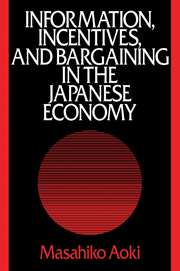 Information, Incentives and Bargaining in the Japanese Economy
Information, Incentives and Bargaining in the Japanese Economy By the time the Pacific War ended with the unconditional surrender of Japan in August 1945, about one-quarter of Japan's national assets (excluding weaponry) existing at the beginning of the year had been destroyed. In the ensuing years, soldiers returning from the battlefields and immigrants from former colonial lands, as well as those released from war materials production, joined the ranks of the job seekers. The number of job seekers during the first few years of the postwar period was about one-quarter of the total labor force. The level of production in 1946 dropped to about 40 percent of the prewar level of 1934-6. For most Japanese, the 1940s were nothing but a series of daily struggles for survival. The entire nation was swept up in great social turmoil and drastic institutional changes.
Upon the new ground of the institutions shaped in the turmoil, however, the engine of growth started to run in the 1950s. An unprecedented growth rate of more than 10 percent per annum was realized throughout the 1960s, and the gains from this growth were widely distributed among diverse social groups. Even so, Japan was still considered a “fragile flower” because of its meager natural resources. Then in the 1970s Japan was hit by a series of shocks - environmental pollution, escalating oil prices, the shift to a flexible exchange system, and new waves of technological innovation.
To save this book to your Kindle, first ensure [email protected] is added to your Approved Personal Document E-mail List under your Personal Document Settings on the Manage Your Content and Devices page of your Amazon account. Then enter the ‘name’ part of your Kindle email address below. Find out more about saving to your Kindle.
Note you can select to save to either the @free.kindle.com or @kindle.com variations. ‘@free.kindle.com’ emails are free but can only be saved to your device when it is connected to wi-fi. ‘@kindle.com’ emails can be delivered even when you are not connected to wi-fi, but note that service fees apply.
Find out more about the Kindle Personal Document Service.
To save content items to your account, please confirm that you agree to abide by our usage policies. If this is the first time you use this feature, you will be asked to authorise Cambridge Core to connect with your account. Find out more about saving content to Dropbox.
To save content items to your account, please confirm that you agree to abide by our usage policies. If this is the first time you use this feature, you will be asked to authorise Cambridge Core to connect with your account. Find out more about saving content to Google Drive.